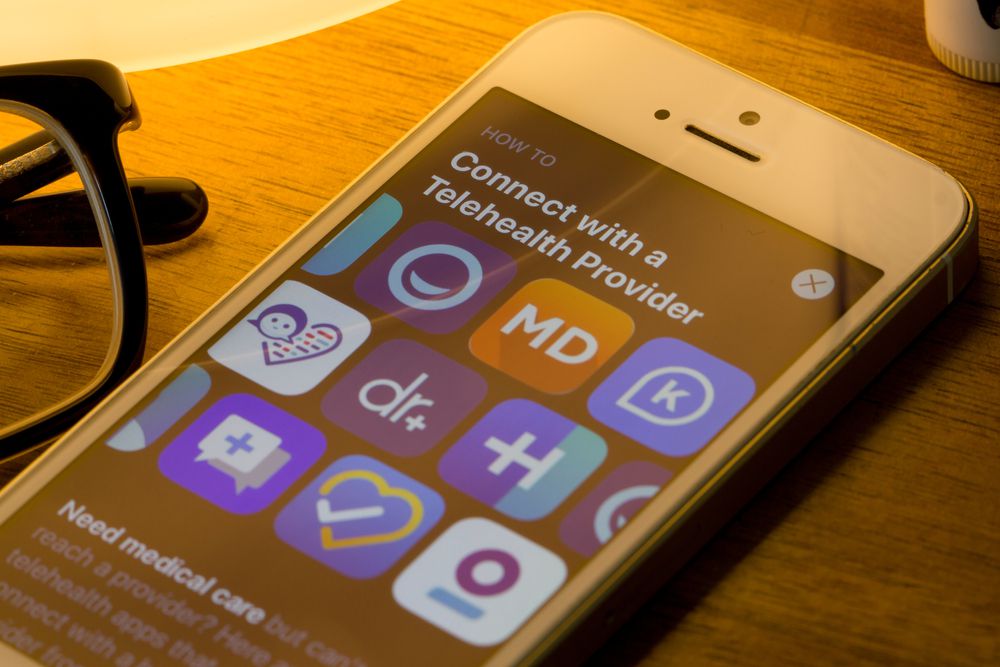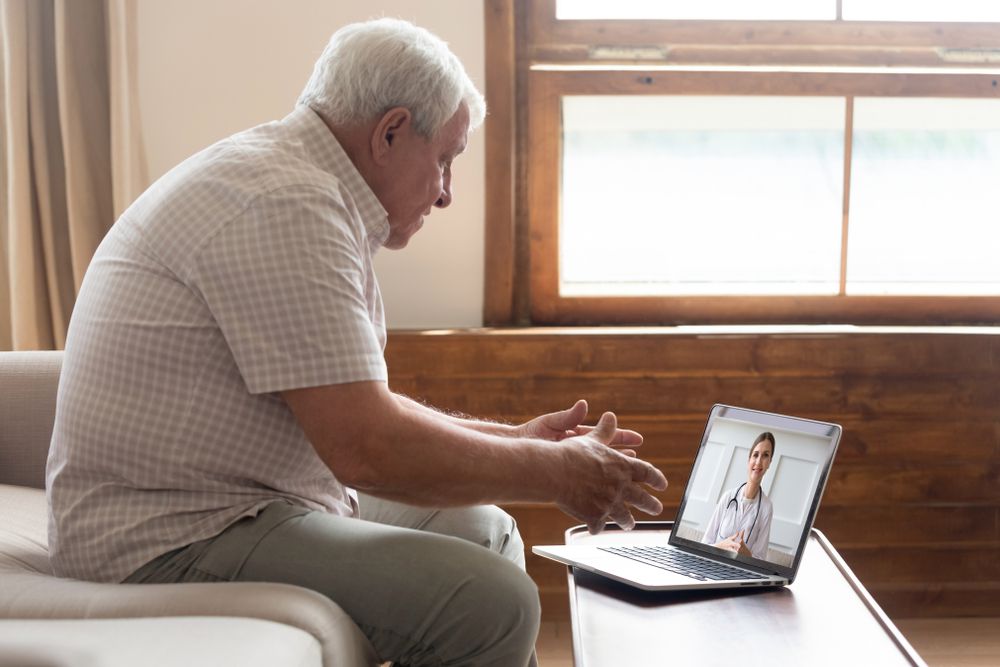People are using remote health services up to 175 times more than they did before the COVID-19 pandemic. It’s estimated that the telehealth market could grow from $3 billion to $250 billion if providers expand the list of available telehealth services beyond urgent care. The statistics are more than promising. However, there are many barriers to telehealth adoption in health facilities that must be addressed before the above numbers can become a reality.
This article will outline the major challenges to implementing telehealth. We will also briefly discuss the possible opportunities of resolving these challenges. Keep reading to learn more!
Top сhallenges of telemedicine implementation in 2023: general overview

Telehealth refers to long-distance medical care that allows patients to get clinical services and medication prescriptions without visiting physical offices.
During the COVID-19 pandemic, enabling remote access to healthcare has become a necessity. According to the 2020 McKinsey survey, 46% of patients used telemedicine in 2020 as a substitute for canceled healthcare visits, compared to 11% of patients in 2019.
While there is an undeniable market demand for telehealth, there are a lot of challenges slowing down its mass adoption. Let’s discuss each of them in detail.
Reimbursement

Federal and state governments decide a significant portion of telehealth policies, including whether or not there should be reimbursement for telemedicine in private insurance plans.
In 2019, only half of the states had service parity. The term service parity means that telemedicine services must be covered in the same way they would be if they were provided during face-to-face appointments.
Another concept called “payment parity” requires the same payment rate for telemedicine services as in-person doctor visits. Before the pandemic, only six states required telehealth services to be reimbursed at the same rate as equivalent offline services.
The lack of legislative efforts to provide equal reimbursement is one of the biggest barriers to telehealth that inhibits the broad adoption of telemedicine services. According to the 2020 Telehealth Impact Study Physician Survey, over 73% of healthcare organizations believe reimbursement will be one of the most significant challenges with telemedicine after lockdown is lifted.
The government has made progress in service and payment parity after the COVID-19 outbreak by implementing laws that made insurance companies and patients pay for telehealth as they would for traditional healthcare. However, only 14 states offer true payment parity, establishing that medical practitioners are reimbursed at the same rate for telemedicine services and in-person medical care.
In general, an unfavorable and unstable regulatory climate creates a lot of uncertainty for healthcare providers. Many providers hesitate to invest money in a telehealth practice since there is the risk that taking this step won’t be financially beneficial to them.
The right telehealth software can partially solve this issue. If a platform has the functionality that allows medical staff to see, before a virtual visit, whether services are covered by an insurance plan or not, providers will be more willing to adopt telemedicine.
Diagnosis accuracy

Examining patients with digital tools is one of the main telemedicine concerns. While misdiagnoses can happen in in-person healthcare as well, there’s a much higher risk when using remote care.
Based on the statistics from CRICO’s national CBS Database, 66% of telemedicine-related claims received from 2014 to 2018 are diagnosis-related. Moreover, the 2019 Doctors Company research suggests that medical malpractice claims are rising along with the adoption of telehealth technology.
Missed diagnoses can hurt both patients and providers. They also drive up the costs of the healthcare system because incorrect diagnoses can lead to wrong prescriptions and potentially harmful treatment. These issues hold back telehealth adoption for providers who want to avoid the risk of medical errors and for patients who don’t want to get hurt because of misdiagnosis.
Digital literacy and accessibility
According to the 2021 Pew Research Center survey, about 7% of American adults don't have an internet connection, and 25% of adults aged 65 and older never go online. In other words, tens of millions of people can’t join video chats with healthcare providers, which distances them from telehealth.
Providers confirm the accessibility issues. Over 64% of healthcare professionals name lack of access to technology as one of the main challenges to implementing telehealth.
According to the American Hospital Association report, almost 40% of people in rural areas lack adequate internet or broadband. This means a lot of local healthcare providers can’t offer telehealth to their patients.
“I cannot perform a telehealth visit on some patients as they don't have a reliable internet connection. Even getting a good phone signal is wishful for them, let alone an internet connection,” says Ashish Risal, an attending physician who works in a rural setting.
Low digital literacy is another major barrier for many categories of patients. For example, seniors with access to technology don’t always have adequate technical skills. Some can’t register their account, initiate a phone call, or understand how a smartphone’s frontal camera works.
In addition, some elderly patients have vision or hearing impairments that make video communication even more difficult. All of this means that solutions targeted at seniors need special features and UX/UI design.
Data security
The medical sector has always been a target for data breaches because providers store large amounts of sensitive information. The healthcare industry suffered over 41.2 thousand stolen medical records in 2019, according to the HIPAA 2019 Healthcare Data Breach Report. This number is probably even higher today, considering that phishing scams and ransomware incidents have increased by 350% during the pandemic.
Telemedicine presents an even greater risk of data-related incidents since video conferencing tools create new loopholes for cyber thieves.
This means that medical providers need to invest extra money to develop tools with robust security and interoperability features as well as encryption protocols. Additional expenses, along with the increased risk of data leakage, are two of the main telemedicine adoption challenges for many healthcare decision-makers.
Strict regulations
Strict regulations continue to be one of the key challenges of telemedicine. Like any other medical software, telehealth platforms must be HIPAA-compliant. If they are not, a healthcare provider can be fined.
HIPAA violations can lead to penalties ranging from $100 to $50,000 per violation (with a maximum of $1.5 million per year). Some violations can also result in criminal charges.
The HHS (Department of Health and Human Services) has simplified the HIPAA requirements for telemedicine software during the lockdown to allow providers to reach more patients. In particular, it announced a limited waiver of HIPAA sanctions for the use of technologies that may not fully comply with HIPAA rules for the period of a public health emergency. But these relaxations of HIPAA restrictions are temporary. In the long run, harsh laws and high fines remain issues with telemedicine that stop providers from embracing telehealth.
Resistance to adopting new technology in healthcare
Not all healthcare providers and patients are confident in the new technology. The pandemic has forced many healthcare professionals to use telemedicine. But if their experience during this period has been negative, it could impact their willingness to offer virtual solutions in the future.
For example, about 58% of medical providers can’t integrate telehealth tools with other systems and EHRs due to weak integration capabilities and poor technical support.
“If I am doing a virtual visit for a rash, I want that screenshot of the rash to be transferred from the device I am using for telehealth into the EHR. But our EHR does not allow this,” says Ashish Risal, an attending physician at Ozarks Healthcare.
There is a similar situation with patients. Some people don’t think video calls are a good alternative to in-person health examinations. Additionally, most telehealth apps have unintuitive interfaces, making them too uncomfortable for users.
Now that we’ve given a good overall picture of telehealth issues and challenges let’s take a closer look at the specific barriers that prevent separate categories of medical providers and patients from widespread telemedicine adoption.
Barriers to telehealth adoption for different parties involved

As with any new technology, people need time to adapt to a new way of delivering and receiving care. Below we want to focus on the challenges in implementing telemedicine.
Small practices and healthcare providers in rural areas

There are many challenges of telehealth in rural areas, but the lack of a tech-oriented mindset is one of the largest.
A staggering 87% of providers still rely on paper and manual processes for patient transactions (basically, for every step of the process from check-in to payment collection). Also, there are many smaller medical practices with relatively small earnings (up to $150,000 yearly income) and old-school practitioners who just don’t want to implement new technologies.
Besides, some health practitioners have already invested a lot of money in paper processes. Despite reports suggesting that paper processes are not sufficient for collecting full payment from patients in a timely manner, these providers don’t want to implement new solutions because they require high upfront costs.
Nurses

Ensuring a smooth user experience and adopting necessary regulations are the main challenges of telemedicine for nurses.
Telenursing doesn’t always require certification, but nurses have to obtain licenses to work remotely in certain states. A lack of multistate licenses prevents them from providing telehealth to patients in other states.
Because of this, nurses must get licensed for telemedicine in several states. This requires a lot of time and effort, which naturally creates a barrier to telemedicine adoption by nursing staff.
Besides, telehealth solutions are rarely optimized for nursing workflows.
“Many telehealth platforms are tailored specifically to provider-patient interactions and not designed to capture the valuable information nurses collect while encountering patients,” says Qianna Regan, the Director of Quality at Chicago Family Health Center.
“For example, some telehealth platforms do not have solid functionality to document teaching opportunities and occurrences performed by nurses.”
On top of that, telehealth software often has complex functionality and interface. So, another challenge of telemedicine for nurses is having to learn the new system and understanding how to use it to examine patients.
Patients

Almost 42% of responders in the 2020 Sykes Americans’ Perceptions of Telehealth survey said they were unfamiliar with telehealth. It’s no wonder. Before the pandemic, people in many states couldn’t even get prescriptions without physically visiting registered clinics and hospitals.
The Drug Enforcement Administration (DEA) has allowed providers to prescribe controlled medications using telemedicine fairly recently, but the government isn’t very vocal about this news. Most patients don’t even know it’s possible to receive adequate clinical services remotely.
Also, low digital literacy is prevalent in rural areas and among the elderly, who don’t depend on technology as much as younger generations. As we mentioned, most people over 65 don’t even use the internet.
That said, the 2020 Survey by McKinsey suggests that 74% of users who tried telehealth had a positive experience. Based on the 2021 Telehealth Impact on Patient Survey, 73% of respondents want to continue to receive remote medical care after the pandemic.
Despite these favorable statistics, patients don’t want to use overly complicated systems. They want straightforward and easy-to-use software. Most people get frustrated with the abundance of features and the need to go through various checks (pre-admission, pre-medication, and pre-reconciliation) before the telemedicine visit. When the system is too hard to use, even patients with a positive attitude towards telehealth instead visit a physical branch and receive care on the spot.
All these factors slow down the telemedicine adoption process. But the good news is that it’s possible to eliminate them. Let’s discuss this next.
How to resolve key telemedicine challenges of telemedicine and accelerate its adoption
While the above barriers might seem hard to overcome, it’s essential to remember that there are both telemedicine challenges and opportunities. In general, widespread telehealth implementation is a positive step for public health systems, providers, and patients since it makes clinical services more accessible and cost-effective. So let’s look at what the main stakeholders can do to speed up the adoption process.
Governments
Federal and state governments should work toward bridging the gaps between telehealth, medical providers, and patients. Their primary goals should be to:
-
Bring clarity to multistate licensure to allow telemedicine and telenursing providers to reach more patients
-
Expand the coverage of telehealth visits and allow more services to be done remotely
-
Grant payment parity between telehealth and in-person visits throughout the country to make virtual services a viable alternative to traditional care
-
Continue investing in digital health services after the pandemic
-
Promote the use of telehealth services to patients, insurers, and payers
The rest of the work has to be done by healthcare facilities and practitioners.
Medical providers
Medical organizations play a crucial role in telehealth adoption since the responsibility for launching telehealth practices lies on their shoulders. Here are the steps they should take to offer remote healthcare services to patients:
-
Study federal and local telehealth laws, including emergency provisions and cybersecurity standards
-
Invest in high-quality equipment to improve the accuracy of health examinations
-
Find an experienced software development team with deep industry knowledge to build custom telehealth software that meets HIPAA rules
-
Include necessary features to help medical staff easily access important patient information and complete other routine tasks during their virtual visit
-
Make the user experience patient-centric by offering an intuitive user interface, smooth online interactions, and adequate technical support
-
Teach medical staff about the features of new telehealth software, as well as patient confidentiality and data security regulations
-
Explain to patients the benefits and possibilities of telemedicine
The main goal of a medical organization should be to build a secure and straightforward software platform that will be easily accessible 24/7.
Overcoming these critical telemedicine adoption challenges can completely transform the way we get medical help. Imagine a ten-month-old baby starts crying at two in the morning. With a telehealth solution, his parents can get the help they need using an app. For example, they can answer a quick series of personal security questions, select the type of health services from a list, apply for a telehealth visit, and receive a call from a health practitioner within half an hour.
That’s the kind of telehealth patients want. But delivering viable software is challenging. Programmers with no experience in healthcare development don’t understand what medical providers or patients want. Those who do rarely have the expertise to build efficient technical solutions. This creates a gap between those who build telehealth software and the people who use it. The result is overcomplicated and unintuitive telemedicine software.
If you want your telehealth solution to be feature-rich and secure but easy-to-use, you need to work with professional programmers who have completed numerous healthcare development projects and understand the industry.
Demigos can examine your processes and build a reliable system that will integrate with your existing IT infrastructure. We can help you create a high-grade telehealth platform according to your requirements without exceeding your budget.
Conclusion
Telehealth can help people receive care on their own terms, whether from home, the office, or abroad. The legal framework for remote medical services is becoming more favorable for healthcare providers, which will help resolve the biggest challenges of telemedicine. Now is the perfect time for medical facilities to adopt the telehealth technology and build a convenient video conferencing system that complies with industry standards and laws.
We can help you develop reliable telehealth solutions specifically tailored to your needs and processes. Feel free to check out our healthcare projects and contact us to learn more about our services.






